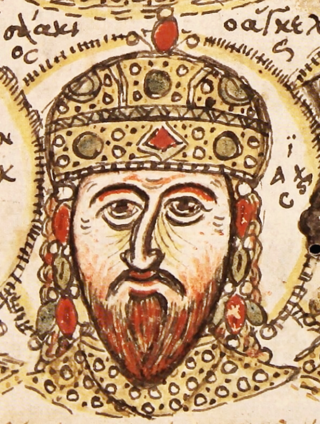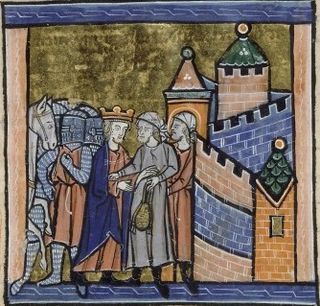Battle
The 15,000-strong Byzantine troops transferred here from Cyprus are approaching the outskirts of the city in battle formation, in front of the troops of the Armenian government of Cilicia led by Thoros II Rubenid (about 10,000 strong). According to John Kinamos's work "Brief History", before becoming a leftist, his army adopts a wedge-shaped battle formation typical of the crusader orders by the order of Andronikos. The Armenian side manages to overtake the Byzantine garrisons unnoticed and inflict a heavy defeat on them with surprise flank attacks. [2]
There are conflicting opinions regarding the use of the "pig's head" battle system by the Byzantines. Nikita Khoniatsi, supplementing Hovhannes Kinamos' thought in his work "History", notes that by that step the Byzantines showed a contemptuous attitude towards the Cilician Armenian statehood. The source information that has reached us attests that after the defeat, Andronikos the horseman, who had lost his troops, approached Toros unnoticed, then knocked him off his horse with a surprise attack. Striking the Armenian prince from behind, Andronikos flees, leaving Toros lying on the ground. However, thanks to reliable armor and a long shield, the Rubenid Prince does not take any significant damage։ [3]

Andronikos I Komnenos, Latinized as Andronicus I Comnenus, was Byzantine emperor from 1183 to 1185. A nephew of John II Komnenos, Andronikos rose to fame in the reign of his cousin Manuel I Komnenos, during which his life was marked by political failures, adventures, scandalous romances, and rivalry with the emperor.

Isaac II Angelos or Angelus was Byzantine Emperor from 1185 to 1195, and co-Emperor with his son Alexios IV Angelos from 1203 to 1204. In a 1185 revolt against the Emperor Andronikos Komnenos, Isaac seized power and rose to the Byzantine throne, establishing the Angelos family as the new imperial dynasty.

John II Komnenos or Comnenus was Byzantine emperor from 1118 to 1143. Also known as "John the Beautiful" or "John the Good", he was the eldest son of Emperor Alexios I Komnenos and Irene Doukaina and the second emperor to rule during the Komnenian restoration of the Byzantine Empire. As he was born to a reigning emperor, he had the status of a porphyrogennetos. John was a pious and dedicated monarch who was determined to undo the damage his empire had suffered following the Battle of Manzikert, half a century earlier.

The Battle of Myriokephalon was a battle between the Byzantine Empire and the Seljuk Turks in the mountains west of Iconium (Konya) in southwestern Turkey on 17 September 1176. The battle was a strategic reverse for the Byzantine forces, who were ambushed when moving through a mountain pass.
Thoros II, also known as Thoros the Great, was the sixth lord of Armenian Cilicia from the Rubenid dynasty from 1144/1145 until 1169.
Mleh I, also Meleh I, was the eighth lord of Armenian Cilicia (1170–1175).

Leo II was the tenth lord of Armenian Cilicia, ruling from 1187 to 1219, and the first king to be crowned, in 1198/9. During his reign, Leo succeeded in establishing Cilician Armenia as a powerful and unified Christian state with a pre-eminence in political affairs. Leo eagerly led his kingdom alongside the armies of the Third Crusade and provided the crusaders with provisions, guides, pack animals and all manner of aid. Under his rule, Armenian power in Cilicia was at its apogee: his kingdom extended from Isauria to the Amanus Mountains.

Isaac Doukas Komnenos was a claimant to the Byzantine Empire and the ruler of Cyprus from 1185 to 1191. Contemporary sources commonly refer to him as the emperor of Cyprus. He lost the island to King Richard I of England during the Third Crusade.

The Armenian Kingdom of Cilicia, also known as Cilician Armenia, Lesser Armenia, Little Armenia or New Armenia, and formerly known as the Armenian Principality of Cilicia, was an Armenian state formed during the High Middle Ages by Armenian refugees fleeing the Seljuk invasion of Armenia. Located outside the Armenian Highlands and distinct from the Kingdom of Armenia of antiquity, it was centered in the Cilicia region northwest of the Gulf of Alexandretta.
Toros I, also Thoros I, was the third lord of Armenian Cilicia.

The Rubenids or Roupenids were an Armenian dynasty who dominated parts of Cilicia, and who established the Armenian Kingdom of Cilicia. The dynasty takes its name from its founder, the Armenian prince Ruben I. The Rubenids were princes, later kings, of Cilicia from around 1080 until they were surpassed by the Hethumids in the mid-thirteenth century.

Ruben I, was the first lord of Armenian Cilicia from c. 1081 until his death. He declared the independence of Cilicia from the Byzantine Empire, thus formally founding the beginning of Armenian rule there. The Rubenid dynasty ruled Cilician Armenia until 1219.
Lampron is a castle near the town of Çamlıyayla in Mersin Province, Turkey. While part of the Armenian Kingdom of Cilicia in the Middle Ages, the castle was known as Lampron and was the ancestral home of the Armenian Hethumid princes. Situated in the Taurus Mountains, the fortress guarded passes to Tarsus and the Cilician Gates.

The Byzantine Empire was ruled by emperors of the Komnenos dynasty for a period of 104 years, from 1081 to about 1185. The Komnenian period comprises the reigns of five emperors, Alexios I, John II, Manuel I, Alexios II and Andronikos I. It was a period of sustained, though ultimately incomplete, restoration of the military, territorial, economic and political position of the Byzantine Empire.
The Battle of Hyelion and Leimocheir saw the almost complete destruction by the Byzantines of a large Seljuq Turk army. The Seljuq army had been raiding Byzantine territory in the Maeander Valley in Anatolia, and had sacked a number of cities. The Byzantine force ambushed the Turks at a river crossing.
Andronikos Komnenos Kontostephanos, Latinized Andronicus Contostephanus, was a major figure in the Byzantine Empire during the reign of his uncle Manuel I Komnenos as a general, admiral, politician and a leading aristocrat.

The siege of Shaizar took place from April 28 to May 21, 1138. The allied forces of the Byzantine Empire, Principality of Antioch and County of Edessa invaded Muslim Syria. Having been repulsed from their main objective, the city of Aleppo, the combined Christian armies took a number of fortified settlements by assault and finally besieged Shaizar, the capital of the Munqidhite Emirate. The siege captured the city, but failed to take the citadel; it resulted in the Emir of Shaizar paying an indemnity and becoming the vassal of the Byzantine emperor. The forces of Zengi, the greatest Muslim prince of the region, skirmished with the allied army but it was too strong for them to risk battle. The campaign underlined the limited nature of Byzantine suzerainty over the northern Crusader states and the lack of common purpose between the Latin princes and the Byzantine emperor.
John Doukas Komnenos was a son of Andronikos Komnenos. Through his father, he was a grandson of Byzantine Emperor John II Komnenos. He was doux of Cyprus from 1155 until his death as well as being appointed a protovestiarios in 1148.
John Komnenos Vatatzes, or simply John Komnenos or John Vatatzes in the sources, was a major military and political figure in the Byzantine Empire during the reigns of Manuel I Komnenos and Alexios II Komnenos. He was born c. 1132, and died of natural causes during a rebellion he raised against Andronikos I Komnenos in 1182.
The Battle of Mamistra took place in 1152 between the forces the Byzantine Empire and Cilician Armenia, near the city of Mamistra. The Armenians under Thoros II were victorious.








